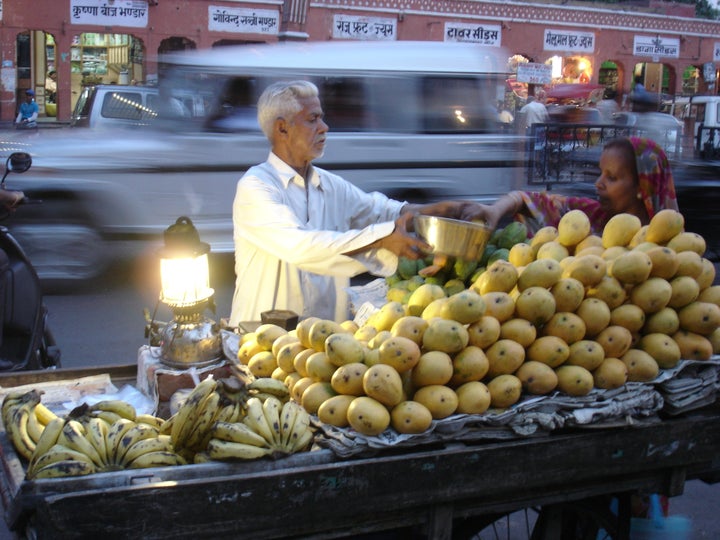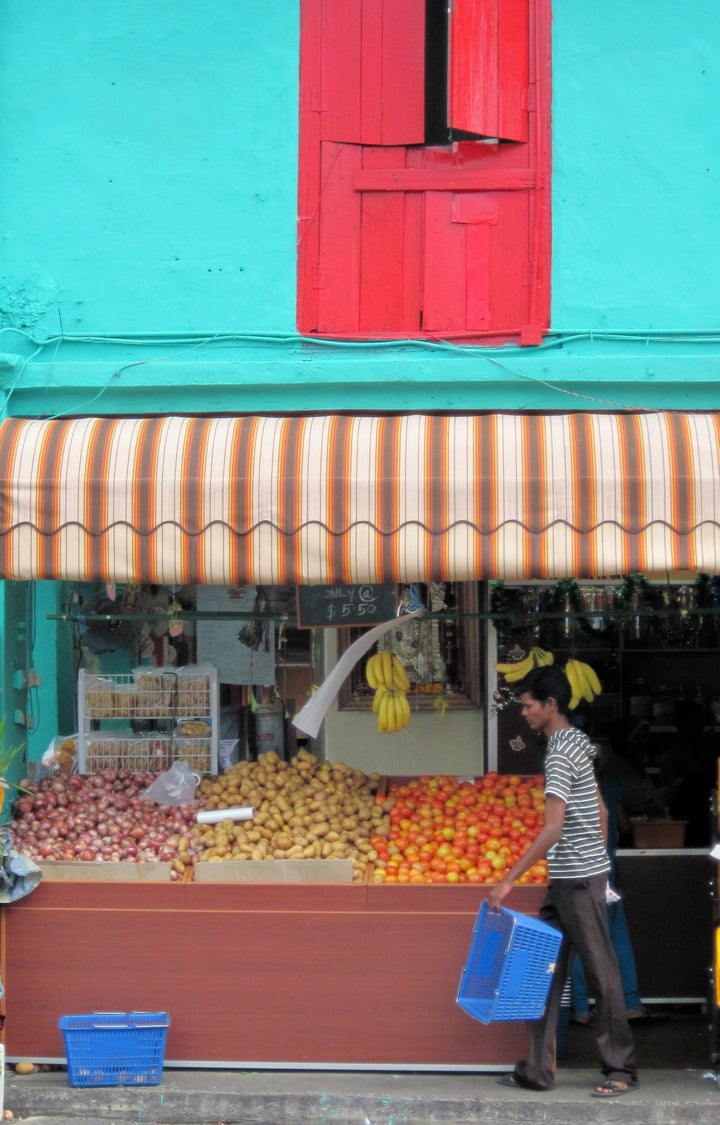Delhi, India, is closed today.
My guide, a solemn man named C.K. Gupta, is deeply apologetic. It is, he informs me, not a holiday, but a peaceful protest. "Too high prices in the shops." It is several years back, and I am in Delhi on vacation. It is my first time here.
Receiving this piece of early-morning information, I am all set for empty sidewalks. The occasional whining ambulance. Maybe a bus.
But when we leave my rented car near the Defence Colony market, it is impossible to move. Trying to walk, I am blocked by the backs of shirts and jackets and saris. An undertow that I do not understand is keeping me in place.

My guide tugs me into a doorway. I am panting. Sweating. "What," I ask, "is going on?"
"Crowded," explains Gupta.
I can see that, I say. "But you said Delhi was closed."
Gupta compresses his face. His eyes are economized into coin slots. "It is closed," he says. "But people have errands. They are hungry. Come with me."
Gupta has me climb the stairs to a restaurant. South Indian Eating Paradise, says the sign. It so happens that Delhi is in northern India. But, for Gupta, this is not a problem.
Our early lunch turns out not to be as filling as I'd thought. "Listen," I say. "I hate to admit this, but I'm still a little hungry."
Gupta examines me.
An analytical man, he watches more than he talks. "Ah," was all he'd said yesterday morning when I'd been lost. Out of a stripe of shadow, Gupta appeared.
"I do not need any help," I had announced. "Ah," replied Gupta, watching, watching. "Ah." He then unfurled his map.
"How about a snack outside?" I suggest. "You could find a vendor. Same south Indian food, let's say, but simpler."
"Tourists do not try this," he says. "Even at a clean place, well, I cannot risk it."
The risk is mine, I say. Let's go.

Street food here, I have read, is a regional thing. Stalls in Delhi and Mumbai will have different techniques and tastes. In 2007, there was a push to enforce new sanitation standards and set up "vending zones" with electricity and running water.
But, despite attempts at regulation, this is India. There are makeshift stands wherever you turn. The street-sellers sell on.
"We call this [street] food chaat," says Gupta, lecturing while I drive. He tells me about a typical sidewalk snack called pani puri, a deep-fried shell made from wheat or other flour, full of boiled potato and tamarind juice. Some of the foods, he adds, will give us tastes of yogurt, chickpeas, "maybe mint" and peanuts.
Fine, I say. All fine.
I park the car at the edge of Old Delhi's Chandni Chowk neighborhood. We take a ride on a bicycle rickshaw for a while (it's welded to the back of an Indian-made Hero-brand bike) and then we get out and try to walk. Streets are miniature and twisted.
After a while, he finds a courtyard — it's partly a driveway for some bikes — that has folding chairs. A card table is topped with a plastic, patterned cover. There is a man with a beard, metal pans and a portable stove.
"Here, you can get more than bite-sized," says Gupta, ordering a masala dosa. For me, he selects the same regional dish I'd tried at the restaurant: uttapam with tomato and onion.
Uttapam, I say. "Sounds like a prescription."
"Probably no one gets sick here," assures Gupta.

So far on my India trip, I have been splurging. The deals are good. My hotel, the Leela Kempinski Gurgaon, has a name that's hard to say. But it's enormous and shiny, with on-site restaurants that are like horns of plenty spilling meats and fruits and cheeses from around the world.
But when our snack is delivered, I realize I am in a different Delhi. The food is served on metal plates, and each of the platters — including chutneys in cups — costs less than 80 rupees, about $1.50. Prices may be high in the stores, but not here.
My uttapam looks the same as it did at lunch: a cross between a pita and pancake. Its toppings seem to be trapped inside. Gupta pours on Day-Glo green and orange relishes without checking first. "Hey," I say.
But when I bite, there's nothing. No fire. Nothing except an onion-y, tomato-y, cilantro taste that makes me want to have more. I do.
"Does this stand have a name?" I ask. Gupta questions the owner, who mulls over my obviously Western looks, then shakes his head. "He says no," translates Gupta. "I think he's worried you might be inspector."
Uttapam tastes like the world's purest pizza. After I'm done, I try a bite of Gupta's masala dosa. It's scrolled up like a crepe. Biting into its quick-fried outer pancake, I get a surprise: a molten core of lentils.
I wave my fork at Gupta. It is missing a prong. Gupta waves his back.
His eyes are following my progress. I add a dab of relish myself — a pink one that makes my food look almost preppy, mixed with the green.
"Now," says Gupta, motioning that I should finish. We move on.

In front of us is an ocean. It's rolling, bobbing, rippling with people. There are islands of stalls. "Tea and coffee selling," explains Gupta.
I can see that, I say.
Gupta leads me to a temporary-looking stand that says Tamil Nadu. "South Indian coffee," he explains. "Try it, please. No germs."
My cup of Tamil coffee is like liquefied candy with caffeine. "These beans get roasted," Gupta announces. "They are powdered. You use only hot milk!"
I promise, I say.
Something at the bottom of his cup gives Gupta an idea. "Enough," he says. "We go now. Time for different tastes."
We are back to New Delhi, moving on more modern sidewalks, and I am struggling to keep up. Gupta pushes open a door. It's a McDonald's. "No," I say. I glance at the menu. A Veggie, Coke and Fries for 180 rupees. A Maharajah Mac.
I turn and leave. Now it is Gupta chasing. "Let us try it," he says.
No, I repeat. This is India.
But we get caught in a pedestrian eddy that is swirling us toward a group of stores. Gupta is pointing. A red and yellow restaurant: one-half Pizza Hut, one-half KFC.
I start to protest. Too late. My guide is focused, narrowing his eyes.

KFC-India’s MasterMeal attracts his gaze. Its picture shows a pair of chicken legs, an unidentified disk and a serving of cheese. Gupta decides on a 195- rupee (about $3.60) Zing Kong Box instead.
“Like in America,” says Gupta. It is not a question. He passes me my share of the Zing Kong’s contents: a fried chicken patty on a bun, a chicken thigh and a side of fries.
The KFC is spicy. It’s not like home at all. For the first time today, I am feeling slightly queasy.
OK, I say. Time for some pizza. I pick a Pizza Hut-India Teekha Veggie (99 rupees, about $1.85) that’s topped with chiles, marinated tomatoes, capsicum, cheese, onion, red paprika, paneer — a type of curd cheese — and baby corn.
Gupta and I dig into the seven-inch pie. It’s not as fresh as my uttapam with tomato onion. But it’s got a kick I like. Maybe it’s the red paprika. Or the peppery corn.
“Need some ketchup?” asks Gupta. He saturates his slice with Heinz.
I am laughing at this, but Gupta is happily chewing. He rolls his pizza up like dosa. He pores over the plastic menu and suddenly points. Pizza Hut-India has Chocolate Truffle Cake With Cottage Cheese.
I am getting full. But this sounds worth a try.
Shall we split one? I say.
Gupta stares. His eyes are like perfect lentils. His mouth is in an upswing. There is the start of a definite curl.
Delhi may be closed for the day. But C.K. Gupta is smiling.
We are in northern India, and it is time for dessert.
Peter Mandel is the author of the read-aloud bestseller Jackhammer Sam (Macmillan/Roaring Brook) and other books for kids, including Zoo Ah-Choooo (Holiday House) and Bun, Onion, Burger (Simon & Schuster).